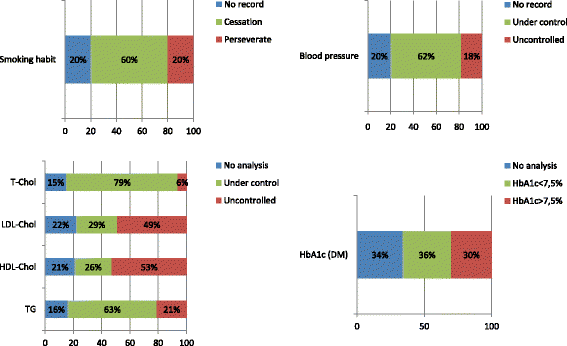Secondary prevention strategies after an acute ST-segment elevation myocardial infarction in the AMI code era: beyond myocardial mechanical reperfusion
- PMID: 28173757
- PMCID: PMC5297147
- DOI: 10.1186/s12872-017-0493-6
Secondary prevention strategies after an acute ST-segment elevation myocardial infarction in the AMI code era: beyond myocardial mechanical reperfusion
Abstract
Background: The AMI code is a regional network enhancing a rapid and widespread access to reperfusion therapy (giving priority to primary angioplasty) in patients with acute ST-segment elevation myocardial infarction (STEMI). We aimed to assess the long-term control of conventional cardiovascular risk factors after a STEMI among patients included in the AMI code registry.
Design and methods: Four hundred and fifty-four patients were prospectively included between June-2009 and April-2013. Clinical characteristics were collected at baseline. The long-term control of cardiovascular risk factors and cardiovascular morbidity/mortality was assessed among the 6-months survivors.
Results: A total of 423 patients overcame the first 6 months after the STEMI episode, of whom 370 (87%) underwent reperfusion therapy (363, 98% of them, with primary angioplasty). At 1-year follow-up, only 263 (62%) had adequate blood pressure control, 123 (29%) had LDL-cholesterol within targeted levels, 126/210 (60%) smokers had withdrawn from their habit and 40/112 (36%) diabetic patients had adequate glycosylated hemoglobin levels. During a median follow-up of 20 (11-30) months, cumulative mortality of 6 month-survivors was 6.1%, with 9.9% of hospital cardiovascular readmissions. The lack of assessment of LDL and HDL-cholesterol were significantly associated with higher mortality and cardiovascular readmission rates.
Conclusions: Whereas implementation of the AMI code resulted in a widespread access to rapid reperfusion therapy, its long-term therapeutic benefit may be partially counterbalanced by a manifestly suboptimal control of cardiovascular risk factors. Further efforts should be devoted to secondary prevention strategies after STEMI.
Keywords: Cardiovascular risk factors; Coronary angioplasty; Prognosis; Reperfusion therapy; ST-segment elevation myocardial infarction; Secondary prevention.
Figures


Similar articles
-
Current characteristics and management of ST elevation and non-ST elevation myocardial infarction in the Tokyo metropolitan area: from the Tokyo CCU network registered cohort.Heart Vessels. 2016 Nov;31(11):1740-1751. doi: 10.1007/s00380-015-0791-9. Epub 2016 Jan 12. Heart Vessels. 2016. PMID: 26758733 Free PMC article.
-
Cardiac and Noncardiac Causes of Long-Term Mortality in ST-Segment-Elevation Acute Myocardial Infarction Patients Who Underwent Primary Percutaneous Coronary Intervention.Circ Cardiovasc Qual Outcomes. 2017 Jan;10(1):e002790. doi: 10.1161/CIRCOUTCOMES.116.002790. Circ Cardiovasc Qual Outcomes. 2017. PMID: 28073848
-
Impact of pre-hospital electrocardiograms on time to treatment and one year outcome in a rural regional ST-segment elevation myocardial infarction network.Catheter Cardiovasc Interv. 2017 Feb 1;89(2):245-251. doi: 10.1002/ccd.26567. Epub 2016 May 3. Catheter Cardiovasc Interv. 2017. PMID: 27142567
-
Meta-analysis of randomized controlled trials comparing percutaneous coronary intervention with aspiration thrombectomy Vs. Conventional percutaneous coronary intervention during ST-segment elevation myocardial infarction.Catheter Cardiovasc Interv. 2016 Jun;87(7):1203-10. doi: 10.1002/ccd.26352. Epub 2015 Dec 23. Catheter Cardiovasc Interv. 2016. PMID: 26699698 Review.
-
Stenting in Primary Percutaneous Coronary Intervention for Acute ST-Segment Elevation Myocardial Infarction.Methodist Debakey Cardiovasc J. 2018 Jan-Mar;14(1):14-22. doi: 10.14797/mdcj-14-1-14. Methodist Debakey Cardiovasc J. 2018. PMID: 29623168 Free PMC article. Review.
Cited by
-
An intensive, structured, mobile devices-based healthcare intervention to optimize the lipid-lowering therapy improves lipid control after an acute coronary syndrome.Front Cardiovasc Med. 2022 Jul 26;9:916031. doi: 10.3389/fcvm.2022.916031. eCollection 2022. Front Cardiovasc Med. 2022. PMID: 35958430 Free PMC article.
-
Ginsenoside Rb1 for Myocardial Ischemia/Reperfusion Injury: Preclinical Evidence and Possible Mechanisms.Oxid Med Cell Longev. 2017;2017:6313625. doi: 10.1155/2017/6313625. Epub 2017 Dec 21. Oxid Med Cell Longev. 2017. PMID: 29430282 Free PMC article.
-
High quality process of care increases one-year survival after acute myocardial infarction (AMI): A cohort study in Italy.PLoS One. 2019 Feb 20;14(2):e0212398. doi: 10.1371/journal.pone.0212398. eCollection 2019. PLoS One. 2019. PMID: 30785928 Free PMC article.
-
Fasudil, a Rho-Kinase Inhibitor, Exerts Cardioprotective Function in Animal Models of Myocardial Ischemia/Reperfusion Injury: A Meta-Analysis and Review of Preclinical Evidence and Possible Mechanisms.Front Pharmacol. 2018 Oct 1;9:1083. doi: 10.3389/fphar.2018.01083. eCollection 2018. Front Pharmacol. 2018. PMID: 30327600 Free PMC article.
-
[Evaluation of a training model for health professionals in the care of critical patients: AIPCAP Study].Aten Primaria. 2020 Mar;52(3):151-158. doi: 10.1016/j.aprim.2018.08.009. Epub 2019 Jan 10. Aten Primaria. 2020. PMID: 30638697 Free PMC article. Spanish.
References
-
- Instituto Nacional de Estadística. Defunciones según la causa de muerte. http://www.ine.es. 2014. Accessed 30 Mar 2016
MeSH terms
Substances
LinkOut - more resources
Full Text Sources
Other Literature Sources
Miscellaneous

